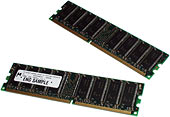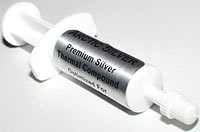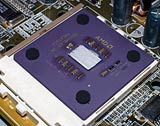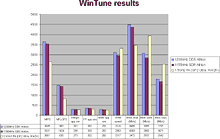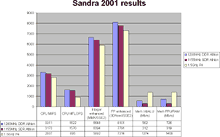
AMD 1.2GHz Athlon with DDR memory
Review date: 14 December 2000.Last modified 03-Dec-2011.
This, ladies and gentlemen, is the world's fastest single processor IBM compatible PC.
And it's not powered by anything made by Intel.
This PC's CPU is a 1200MHz - 1.2GHz - AMD Athlon, and its memory is 256Mb of 266MHz Double Data Rate (DDR) SDRAM.
The memory clock speed, and the Front Side Bus (FSB) speed for the processor depending on how you define the terms, is only 133MHz. But both the RAM and the CPU-to-chipset buses perform an operation on both the rising and falling sides of each clock "tick", so the real bus speed for both subsystems is 266MHz.
266MHz DDR memory's described as "PC2100", making it sound rather grander than every other PC-something flavour. That's because it's named according to its theoretical bandwidth in megabytes per second, instead of the simple bus-speed naming of Standard Data Rate (SDR) SDRAM. PC2100 is the top-spec 266MHz stuff. 200MHz DDR RAM is PC1600, and that's got the same theoretical peak bandwidth as single channel PC800 Rambus RDRAM. The P4 uses dual channel RDRAM, for twice as much bandwidth.
Theoretical peak bandwidth is, in case you're wondering, absolutely as informative as an "up to 50% off" sign in a shop window.
The 1.2GHz Athlon, even backed by the plain Standard Data Rate (SDR) 100MHz SDRAM that other recent AMD-powered PCs use, is a redoubtable processor. Give it memory more than twice as fast and it gets a further leg-up, establishing this platform as conclusively the fastest you can buy today.
Which is something Intel would rather you didn't know.
Their 1.4 and 1.5GHz Pentium 4 CPUs, after all, are supposed to be the top of the PC-compatible heap at the moment. The "undisputed king of microprocessors", even.
The P4 is, arguably, more technologically advanced than the Athlon, it has even faster memory (well, it does if you believe Rambus, anyway; all P4 machines for a while yet will come with no memory option but Rambus RDRAM), and, importantly, it costs a lot more.
So the P4 ought to be considerably better.
But it isn't, as I discuss in detail in my review of the new Intel chip, here.
The P4, even at its current speeds, can deliver the brutally fast performance to pretty much match Intel's PR - but only on software that's suited to it, or specially tweaked for it. And, at the moment, practically nothing is.
In the future, P4s running at higher clock speeds, with more software that explicitly supports the P4's bells and whistles, will probably make Intel's chip a real bang-per-buck contender. But at the moment even the 1.5GHz P4 with top-spec PC800 RDRAM is not much faster than a 1GHz SDR-RAM Athlon box.
And you can buy a whole 1GHz Athlon computer, ready to go with a 17 inch monitor and all the other trimmings, for about the same price as a Pentium 4 CPU, motherboard and 128Mb of RDRAM, here in Australia at least.
Retailers here have so little interest in shifting separate P4-system components - as opposed to whole built computers, with slower PC600 memory and other low-cost components to keep the price down and the uneducated punters happy - that the few that even bother stocking P4 parts are charging highly fanciful prices.
People that buy "budget" PC600-memory 1.4GHz P4 systems, or the upcoming 1.3GHz cheapie version, will end up with an even less exciting computing experience. Though perhaps still better value for money than 1.5GHz, PC800-RAM machines.
The processor world changes quickly, but at the moment the Athlon's a lot tastier than the P4, and has a less impressive but still worthwhile price and power advantage over the P-III, too.
The Athlon uses an Alpha-derived EV6 CPU bus, in which the CPU-to-chipset communication speed's twice the speed of the Front Side Bus (FSB). The default FSB for Athlon systems before the DDR machines has been 100MHz, and that's the speed at which the CPU can talk to RAM.
Many current Athlon systems can be overclocked considerably (to the tune of 20% or so) by winding up the FSB setting, and the RAM speed with it. That increases the RAM bandwidth proportionately, but even a 33% RAM speed change has little impact on real system speed, for desktop tasks. The extra CPU core speed from an FSB overclock makes a difference; the extra RAM speed doesn't.
A few Athlon motherboards also let you adjust RAM speed independently of the FSB, but boosting the RAM speed to 133MHz when the FSB's still 100MHz makes no real difference to anything. The FSB bottlenecks the RAM performance.
Real 266MHz speed from the CPU to the RAM, though, makes a big difference to memory performance.
So how's the new flavour of Athlon system, with much more memory bandwidth and 1GHz and higher CPU speeds, stack up? What do you lose if you opt for a currently available Athlon system right now, instead of waiting for DDR gear to hit the shelves? And if you've got a fast Athlon box at the moment, is DDR enough of a plus to make it worth upgrading?
Bits and pieces
The motherboard in the review machine was one of AMD's own Corona EVT8 boards, the reference design on which various retail boards will be based.
The cooler on this Athlon's no overclocker's dream, but high speed Athlons are made to run hot. This one didn't miss a beat in my testing, in an un-air-conditioned room in Sydney during a 38 degree Centigrade (100 degrees Fahrenheit, kids) heat wave.
The two 128Mb DDR SDRAM modules. They're superficially similar to ordinary SDRAM DIMMS, but they use a different kind of slot.
Compatibility
Unlike the P4, the DDR Athlons are an evolutionary change, not a revolutionary one.
There's actually nothing "DDR" about the new-model 133MHz FSB Athlons (266MHz after doubling, remember...); you can plug them into any old Socket A motherboard and they ought to work. Likewise, you should be able to plug an old-model Socket A Athlon into a DDR motherboard and have it work normally.
Well, that's the idea, anyway; the early non-retail boards don't recognise the old model processors properly, but retail boards should be fine.
It's possible for DDR-capable Athlon motherboards to also work with plain PC133 SDRAM, as well; some DDR RAM controllers (but not the one on this board) understand SDR RAM as well.
But because the DDR RAM modules need a different connector, motherboards that support both kinds of RAM will need both kinds of RAM slot, and not many manufacturers are likely to be crazy about making such a board.
If you do the forward-compatibility thing and plug a 1.0, 1.13 or 1.2GHz 133MHz-FSB Athlon into a plain 100MHz FSB board, it'll only run at 750, 850 or 900MHz, respectively.
As all Athlon tweakers know, this is because of the locked multiplier. Like Intel CPUs for a while now, AMD Socket A processors are meant to run at a fixed multiple of the Front Side Bus speed. Change the FSB, change the core speed.
If you've got an SDR-RAM Socket A motherboard that can tolerate having the FSB goosed up by 33MHz, you can run a 133MHz FSB Athlon at its stock core speed and multiplier. But 33MHz extra is rather a lot to ask of even the best 100MHz Socket A boards; you can get better core speeds much more elegantly by unlocking the multiplier.
Unlike the Intel multiplier lock, the AMD one is easily defeated, by re-connecting the four laser-cut "L1" bridges on the surface of the processor. I talk about this in more detail in my article here, but in brief, a sharp pencil does the job just fine. The graphite is sufficiently conductive. And then, on motherboards that support multiplier adjustment, you can wind the CPU speed up or down as you like, without fooling with the FSB.
You can't do this on the AMD DDR motherboard, though; it has no CPU setting adjustment features in the BIOS, and without documentation for the motherboard DIP switches, I didn't have the energy to try to find out what the overclocking possibilities of the new-model 1.2GHz chip were.
But you can tweak the multiplier on an Abit KT7, which I review in the same piece in which I explain the pencil trick.
Which allowed for the easy creation of a good comparison system, to see just how well the DDR box fared against a plain-RAM Socket A machine.
The CPU for this second machine had also kindly been supplied to me by AMD. It was only a 1GHz chip, though, so it was...
Overclockin' time!
To give the 1GHz chip the best chance of running stably at a core speed pretty close to that of the DDR machine, I dug out my faithful Alpha PAL6035MUC CPU cooler, which with its very flat copper-inlay base plate and huge surface area is still pretty much the best socket-CPU cooler you can buy.
The current PAL-series coolers have a base plate equipped with little feet to let them fit correctly on current Socket 370 CPUs, but this older model flat-plate one works fine on Socket A chips, because of the rubber spacer dots stuck to the CPU.
HighSpeed PC had kindly provided me with a syringe of Arctic Silver thermal compound, so I used that between the Athlon and its big fat cooler.
The Arctic Silver compound is loaded with tiny silver particles, and it looks like gelled-up ink from a silver pen. The silver particles have better conductivity than the zinc oxide particles in ordinary thermal grease, so the special compound works better.
And, despite its silver content, it's not electrically conductive - my multimeter said it still had more than 2 megaohms of resistance, even when the probes were in a blob of the stuff and very nearly touching. So a misplaced blob can't fry your CPU or motherboard.
At only $US13.95 for a 6.5 gram tube (which is enough to do a lot of CPUs), you might as well get some of this stuff. The difference in performance between the Arctic Silver and much cheaper thermal compounds may give you more system stability at a given speed, or it may not. But it's not as if you've got to pay a million bucks for the stuff, so you might as well have the best.
Aus PC Market, by the way, now stock Arctic Silver paste and epoxy, so shoppers in Australia and New Zealand can get it cheaper than they could from the States. Click here if you're in the Antipodes and want to place an order!
Applying thermal compound between older CPUs and most heat sinks is a pretty high-tolerance sort of affair, because the two surfaces aren't likely to be very flat, and you'll need quite a lot of thermal compound to fill the gap. Not a great peanut butter dollop, but a fully opaque smear, with extra little dabs here and there to cover really badly matched spots.
Applying thermal compound between a very flat lapped-base cooler like the Alpha and a more recent small-die CPU like the current Socket A and Socket 370 chips, though, makes you feel a lot more like someone assembling a nuclear device. You finger is no longer an acceptable thermal compound application tool - though the edge of a credit card will do, in a pinch - and the amount of grease you need is likely to be small enough that you can see the markings on the CPU through it.
Unfortunately, despite the best efforts of the ultra-conductive grease, this CPU didn't want to do 1200MHz. Its stock multiplier is 10, but it didn't like running at any multiplier above 10.5, for some reason. The best I could manage stably (well, stably enough to run benchmarks, anyway; I wouldn't want an over-overclocked CPU in charge of my heart-lung machine) was 110MHz FSB times 10.5, for 1155MHz core speed.
That's only about 4% off the core speed of the DDR machine, though, so it'll do for comparison purposes.
I could maybe have got a bit more out of the CPU if I ran it at more than the normal maximum of 1.85 volts. You can modify the voltage regulator circuit for more juice easily enough - see here for how to do it on a KT7, for instance. But that's dicing with death if you're just using air cooling.
The heck with it; 1155 was good enough, and the KT7's CPU bus adjustment let me leave the RAM speed alone, so this was a pretty straight comparison of the difference between stock 100MHz SDRAM and 266MHz DDR memory.
But first, a wet blanket.
Where speed matters
All of the DDR (and RDRAM, for that matter) hype sounds very exciting, but it is important to remember two points.
Point 1: For desktop computers, RAM speed is not tremendously important.
The big deal about these new Athlon systems is the new, faster DDR memory, but it's not as big a deal as you might think, even if it is at least twice as fast as the memory Athlons used before.
The modern IBM compatible PC has a CPU that can suck bits in and blow them back out again much faster than main RAM can deliver or accept them.
Buy a 1GHz Pentium III system, for instance, and unless you're one of the few, the proud, the raving mad, who've got a machine based on Intel's bug-plagued i820 or server-targeted i840 (which wasn't entirely erratum-free either) RDRAM chipsets, you get a machine with 133MHz RAM and a processor whose core runs 7.5 times faster.
This creates an obvious problem. What happens when the CPU needs more memory speed than the memory can provide? It doesn't matter if you can bake a loaf of bread in one second, if it takes you a week to get the bread out of the oven afterwards and get another batch of dough together.
This problem, though, doesn't arise nearly as much as you might think.
The reason why modern processors don't get starved for RAM bandwidth is simple enough - cache. The CPUs have blocks of super-fast RAM built in, and they use that (enable Gross Simplification Mode) to hold data they're working on, and to buffer output so the CPU doesn't have to wait for main RAM to deal with write operations. And clever algorithms endeavour to make sure that the cache has data that's likely to be needed loaded into it before the CPU gets around to asking for it (conclude Gross Simplification).
Most of the tasks done by desktop computers don't need more data flow to and from RAM than can be handled by relatively slow RAM and a good-sized cache to smooth out the peaks in the memory access graph. So this system works well.
Minicomputers, mainframes and specialised workstations that flog the heck out of their RAM all day, because they're doing weather simulation or monstrous database operations or some other kind of advanced computing, are different. Give them desktop computer RAM speed and their performance would plummet.
But ordinary PCs don't do those kinds of jobs, and so get along OK with pleasingly cheap, lower speed memory.
About the most demanding applications most desktop machines run are 3D games. Games can stress the CPU and the RAM considerably, but they're still not in the nuclear-bomb-simulation class of computing task. So doubling your RAM speed still doesn't double your frame rate. Far from it, in fact.
The second point to remember when you're oohing and aahing over the performance of the latest and greatest PC platforms is that, for many tasks, system speed just doesn't matter much at all.
If you're running ordinary office applications, browsing the Web, playing 2D or undemanding 3D games, you can do so with perfect efficiency on a system based on any current AMD or Intel CPU, and on quite a few that you can't even buy new any more. 400MHz Celeron? No worries. Plenty of power.
You need adequate RAM for Windows machines; 128Mb for Win95-series computers, at least 192Mb for WinNT-series ones, to minimise drive flogging in normal operation. But if you've got that - and with current RAM prices, it's not hard to get - then CPU company sales spiels notwithstanding, you do not need some steaming 1GHz-plus processor and the latest you-beaut RAM.
From now on, though, let's assume that for good reasons or bad, you do find yourself in the market for an IBM compatible sufficiently powerful that other microchip-equipped devices in your home or office might reasonably be expected to spontaneously decide to sacrifice pocket calculators to it in the dead of night.
Time to benchmark.
Performance
All quickie benchmark programs are pretty similar, and pretty similarly misleading. If you know what you're looking for, they can tell you something worthwhile, but anything that can do six repetitions of its whole bench suite in the period of time taken for a normal person to make a sandwich is not going to give you a good idea of overall system performance.
I like to use the downloadable version of WinTune for these sorts of rough-guess measurements. Here's an ugly Excel chart of the comparative performance of the DDR 1.2GHz Athlon, my 1155MHz SDR system, and the 1.5GHz P4 I tested earlier.
For the synthetic CPU speed tests - which, I stress, don't tell you a lot about system performance for most real tasks - the 1.2GHz Athlon beats the 1.155GHz system by only about as much as you'd expect, considering their slightly different clock speeds. Synthetic benchmarks do little to no input/output, so this isn't surprising; the RAM's never even touched.
The P4 lags behind on the MFLOPS (Millions of Floating Point Operations Per Second), floating point application simulation and MMX application simulation tests, primarily because they don't use its new Streaming SIMD Extensions 2 instruction set.
Most of these "new" instructions are just things that the previous MMX and SSE instruction sets did in the Pentium MMX, Pentium II and Pentium III. But new P4 strings are attached to the old bells, and software that doesn't know how to pull them gets lacklustre results.
The aggregate "RAM Speed" score is just the other three scores averaged; relatively lightweight RAM tests like this are notoriously inaccurate, and this one can barely tell the difference between the three memory types.
Another quickie benchmark that can tell the difference between RAM subsystems - though often reports that difference in, ah, whimsical ways - is SiSoft Sandra. The current version of Sandra has 1.5GHz dual channel PC800 P4 comparison numbers built in.
Here's another -5 Graph of Hideousness (its Dungeons and Dragons designation), this time showing Sandra's opinion of the relative performance of the 1155 and 1200MHz Athlons, and the 1.5GHz P4.
The P4's ghastly performance for the plain MFLOPS test is just what happens when software doesn't know about SSE2. Use SSE2 for the exact same test (a plain vanilla Whetstone benchmark) and the P4's score jumps to 1825, beating both Athlons.
The "enhanced" tests are using the CPUs' enhanced instruction sets - MMX and 3DNow! for the AMD chips, SSE2 for the P4. Still little weeny synthetic tests, still no benefit from RAM bandwidth.
Sandra's RAM speed benchmarks are known to be, to use a technical term, wiggy. It doesn't do plain dumb bulk data moves, but actually performs real operations on large data arrays, which ought to give more useful numbers. What you actually get, though, are results that are generally comparable across systems that use the same chipset and RAM type - but all bets are off for cross-chipset comparisons.
The comparative RAM speed figures for the two Athlons make sense, and the P4's RDRAM comes in around twice as fast as the PC2100 DDR memory. Which is pretty much right, since dual channel PC800 memory has an aggregate bandwidth of 3200 megabytes per second - it can't always deliver that much speed, because it's composed of two 1600Mb/s channels and not one amorphous blob of bandwidth, but for Sandra's purposes, it does.
In any case, RAM benchmarks are of purely academic interest if, as explained above, they don't have much of an impact on system performance. So enough of the synthetic benchmarks. What about real world tasks?
Ziff Davis' recently released Winstone 2001 benchmarks are exhaustive Windows application performance tests. They run real application code from a variety of real big-name applications, and give a handy-dandy single number at the end that's easy for the proletariat to remember.
Business Winstone 2001 runs code from Norton Antivirus, Winzip, Microsoft FrontPage, Access, Excel, PowerPoint, Project and Word, Lotus Notes and Netscape Communicator.
Content Creation Winstone 2001 does the same sort of thing with code from Adobe Photoshop and Premiere, Macromedia Director and Dreamweaver, Netscape Navigator and Sonic Foundry Sound Forge.
With single-number output, there's no point drawing a graph; the results for the two Athlons were:
| 1200MHz DDR Athlon | 1155MHz SDR Athlon | Ratio | |
| Business Winstone 2001 | 45.3 | 35.5 | 1.28 |
| CC Winstone 2001 | 51.4 | 37 | 1.39 |
There's your real world, real application difference, folks.
The SDR Athlon was running the exact same video card as the DDR one - an Asus V7700 Pure 64Mb GeForce2, using the v6.31 drivers.
The DDR system came with non-standard, and marginally faster, v6.27 drivers installed, but I couldn't get hold of that driver version to install it on the SDR machine, and presumably there's something in it that works better on high RAM bandwidth systems. The difference in video tests was only a couple of percentage points, though.
Th SDR machine's hard drive was a 20Gb Quantum Fireball Plus LM, versus the 30Gb IBM DeskStar 75GXP DTLA-307030 in the DDR box, but both drives are 7200RPM units with similar specs, overall. The IBM drive can manage significantly higher sustained transfer rates, but the Quantum has slightly better seek speed. So the hard drive was not what made the difference.
And with only a 4% faster CPU core speed, the DDR machine wasn't just winning because it did more RPM.
The higher RAM speed in the DDR machine is the only thing that could have made most of this difference. Now, it's got 2.66 times the theoretical RAM bandwidth of the SDR box, and that only added up to a 30 to 40% difference in the Winstone tests, but it's still a noticeable change.
If you're running serious productivity apps, DDR is worth having.
Unfortunately, I got my hands on the Winstone 2001 discs after my P4 test, so I don't have comparative numbers for that machine.
In case you're wondering, by the way, the Winstone performance metric is based on a reference score of 10, which is achieved by a rather antiquated "base machine", with 64Mb of RAM, a 333MHz P-II, crummy 4Mb Cirrus Logic 5465 video card, running in only 800 by 600 in 16 bit colour.
You can buy a used computer like this from a dealer these days and pay only $AU650 or so for the whole enchilada - including screen and speakers and modem and so on. But the fire-breathing DDR box only beats this humble base machine by factors of 4.5 and 5.1 for the two Winstones. This despite the fact that the Athlon has four times the memory running four times faster, 16 times as much graphics memory on a much faster graphics card (even for 2D tasks), a CPU with superior clock-for-clock performance that's running at 3.6 times the clock speed, and a faster hard drive as well.
This gets us back to the issue of when component performance changes actually make a difference, and when they don't. Generally speaking, a performance difference of less than 10% isn't noticeable. And improving the performance of some subsystem, like the CPU, by 10% will give you a smaller than 10% difference in system performance, unless the subsystem you changed was the only limiting factor for whatever it is that you're doing.
On to a game - Quake III Arena, to be exact. Its two standard demos are of fairly hectic deathmatch action, and 3D games can be pretty hard on system RAM.
They'll only actually be hard on RAM speed, though, if you're using fast AGP modes to shunt texture data to a video card without enough storage of its own, or if the CPU's doing a quite amazing amount of geometry and physics calculation, or if you're running without 3D acceleration and making the CPU do all of the work itself.
None of these situations are terribly likely, on current systems. Most people have, and use, 3D accelerators with quite a lot of RAM. And they wind up the resolution and pretty-settings until they start to see a significant frame rate drop.
On a top-flight faster-than-1GHz system with a GeForce2, you can wind the settings up a lot before that happens, but when you manage it on a high speed PC, the limiting factor is likely to be your video card's fill rate - how fast it paints the screen - not your RAM or CPU speed.
I tested the standard Q3A Demo1 in High Quality mode - which uses only 800 by 600 resolution and doesn't use maximum texture or geometric detail - and in 1280 by 1024 mode, with texture and geometry detail both turned up to the maximum settings.
The results:
| 1200MHz DDR Athlon | 1155MHz SDR Athlon | Ratio | |
| High quality | 134 | 112.7 | 1.19 |
| 1280 by 1024 maximum quality | 55.6 | 55.1 | 1.01 |
Be still, my beating heart.
I could have fabricated a more impressive win for the DDR machine by doing Quake 2 tests in software mode, or something (actually, I just did; the DDR box running in 1024 by 768, software mode, got 31fps for Q2 demo2; the SDR box got 23), but the above numbers are more representative of what you're really likely to see. A modest win in lower quality modes, a dead heat when you're asking enough of the graphics subsystem that the rest of the computer's waiting for it.
With 64Mb of memory on the graphics card, it's unlikely to have to hit system RAM during gameplay. Video cards with lots of RAM are a continuation of the PC-compatible big-caches philosophy, and they smooth out lousy transfer rates between components in exactly the same way.
Quake III tests OpenGL game performance; Mad Onion's 3DMark2000 tests the other popular 3D Application Programming Interface (API), Direct3D. 3DMark2000 uses the Direct3D engine of the upcoming (for rather a while) game Max Payne, so it's supposed to give reliable results.
The stock 3DMark2000 test runs in only 1024 by 768, 16 bit colour, so it doesn't greatly load the graphics subsystem, and ought to let some RAM speed shine though. Well, maybe. Let's see, shall we?
| 1200MHz DDR Athlon | 1155MHz SDR Athlon | Ratio | |
| Default benchmark 3DMarks | 7632 | 6672 | 1.14 |
| 3DMark2000 CPU score | 615 | 479 | 1.28 |
Once again: Whoopee. A difference, sure, but not one to get all pink and sweaty about.
The 3DMark2000 "CPU" score is quite heavily graphics card dependent, but with both machines equipped with the exact same card and drivers, this wasn't a variable.
You might be able to perceive a 14% frame rate improvement, but only if you didn't start from a frame rate more than twice as high as your screen refresh rate - which, with a trans-1GHz Athlon and GeForce2 GTS running in only 1024 by 768, 16 bit colour, you probably wouldn't.
Incidentally, current P4 systems stink for this test. The Max Payne engine, and video card drivers, are not yet optimised at all for the P4, and a 1.5GHz P4 even with a GeForce2 Ultra still gets a 3DMark2000 CPU score below 460.
Greetings to fellow members of the distributed.net network. When I tested the P4, I found that it plumbed new depths of awfulness for distributed.net purposes; either there's room for some serious optimisation in the client software, or the P4's design is just fundamentally unsuited to the tasks of cracking RC5 encryption and calculating Optimal Golomb Rulers.
The distributed.net work involves lots of hard-core chewing on small data sets that don't need much RAM involvement, so there's pretty much no benefit at all to having speedy memory - even cache size makes little difference. Without further ado, the numbers:
| 1200MHz DDR Athlon | 1155MHz SDR Athlon | 1.5GHz Pentium 4 | |
| RC5 (kilokeys/second) | 4280 | 4119 | 1979 |
| OGR (kilonodes/second) | 9706 | 9291 | 5426 |
Clock for clock, the two Athlons are dead even. Actually, they're even clock-for-clock with a cheap Duron machine, as well - a Duron at 800MHz will do exactly 2/3rds of the 1.2GHz DDR machine's score.
The P4 pretty much wraps its teeth around the first hurdle in this, rather obscure, test. At least this is one test where the P4 shouldn't do any worse if it's running cheaper PC700 or PC600 memory.
Clock-for-clock scores aren't actually very useful for cross-processor comparisons, because few real world performance measurements scale linearly with CPU speed. Yes, distributed.net performance does, but 3D game performance doesn't, and neither do other CPU-intensive real world desktop computer tasks like image editing or video effect rendering.
Double your CPU speed and you won't see twice the speed from these more complex tasks, because they are at least partly limited by the speed of the RAM and the hard disk.
Clock-for-clock scores are useful, though, for comparing processors of the one family but running at different speeds. If, say, a 1000MHz Athlon PC beats an otherwise identical 750MHz Athlon box by 20% for a given task, its clock-for-clock performance is only 0.9 of the slower machine. That gives you an indication of how much the CPU speed contributes to system performance for that task.
Pricing
AMD aren't doing a big marketing blitz about the DDR systems, which is fair enough, because there isn't a revolutionary performance improvement. Neither is there likely to be a huge price hike, though; motherboard, RAM and chip pricing may start high as the dealers milk the early adopters, then should rapidly settle down to not much more than what SDR systems cost at the moment. According to AMD's PR people here in Australia, 266MHz bus CPUs should be priced (in thousand unit quantities) the same as 100MHz ones with the same clock speed. Bargain.
Plain 100MHz FSB 1.2GHz Athlons in thousand unit quantities are now, wait for it, $US254 each.
At the moment, PC2100 DDR memory on sale in the States costs more than $US200, retail, for a 128Mb module. But practically nobody can use it yet, so that price doesn't mean much. It's like the ridiculous prices for P4 CPUs, before anyone was selling the motherboards to put them on.
As I write this, Intel still charge OEMs $US819 per chip for bare 1.5GHz P4s in thousand unit quantities, with no fancy RAM bundle. The 1.4GHz chip's down to $US574, though - 70% of the price for 93% of the speed.
Hit pricewatch.com, and you'll find P4s at $US859 and $US609 for 1.5 and 1.4GHz, and 1.2, 1.1 and 1.0GHz 100MHz FSB Athlons for $US277, $US226 and $US180, respectively.
Low price for a P4 motherboard? $US309. Low price for a quality Socket A board like the KT7 in my SDR machine? $US122.
128Mb of PC133 SDRAM for the Athlon board? $US42. Maybe $US60, if you want something with a good brand on it.
128Mb of RDRAM for your P4 board? You'll need two 64Mb modules, because the Dual Rambus architecture needs an even number of modules installed, and you'll pay at least $US85 each for them, even for crummy PC600 memory that chops back the P4's performance noticeably. PC700 or PC800 will cost you $US100 per module, at least.
I'm quoting US prices here because Australian retail prices for P4 gear are hard to figure out. There are some dealers listing outrageous prices for bare P4s and their accoutrements, because they're not really interested in selling the things but want to ward off calls from people asking how much they cost. And there are plenty of system vendors selling P4 boxes, but it's hard to dig the price of the core components out of the price of a built PC.
Lots of people are selling Athlon gear, though; locally, you can get a 1.1GHz Athlon, KT7 motherboard and 128Mb of RAM for little more than $AU1000. Settle for 1GHz and you're talking about $AU900.
Or, of course, you could choose a Duron instead.
Durons are, beyond question, the best value for money CPU on the market today. They're a cut-down Athlon in the same way that the Intel Celeron's a cut-down Pentium II or III (depending on the Celeron - models from the Celeron 533A upwards are Pentium III based). The P-II based Celerons run pretty much exactly as fast as a P-II at the same clock speed; the P-III based ones are faster, clock-for-clock, than the older models, but slower than a full P-III.
The Duron, on the other hand, is quite close to the speed of a full Athlon, and you can get an 800MHz one, with a CPU cooler, delivered, for $AU220. It's roughly as fast as a P-III at the same clock speed, but an 800MHz P-III costs $500. So a Duron is by no means a bad choice, even for power users, and you can unlock their multiplier and wind up their core speed in just the same way as you can with an Athlon, if you like. Advertisement concludes.
What to choose
For really serious PC workstation computing, it would appear that a dual CPU system is still very much the way to go. At the moment, that means dual P-IIIs, since the P4 is at the moment very definitely single processor only, and the Athlon doesn't yet have any dual CPU motherboards - it seems plausible that such boards will be along before the middle of 2001.
If a single processor is good enough for you, though - and if you're running Windows 95, 98 or ME it had better be, because those operating systems can't make of use more than one CPU - then a DDR Athlon system looks like a very good buy.
Since there's no compatibility break between the 100 and 133MHz bus speed Athlons, people without a ton of cash can mix and match their components. If you've got a DDR motherboard and RAM to match, you don't need to buy a new 133MHz chip to go with it; an older 100MHz one should work, so you can just stick an Athlon from an older Socket A machine into the newer one while you wait for the prices of the faster chips to drop.
If DDR componentry, when it's widely available, ends up being not much more expensive than the SDR equivalent, then DDR Athlon systems will be a big pain in the rear for Intel for rather a while yet. If DDR gear's greatly more expensive, though - as it may well be soon after release - there'll be no point buying it unless you run odd, RAM-heavy applications, or just have to have a money-is-no-object poseur PC.
Barring big price gaps, DDR Athlon machines should be a brilliant option for shoppers looking for serious power at a reasonable price.
Review DDR Athlon system and comparison CPU kindly provided by AMD Australia.
Arctic Silver thermal compound kindly provided by HighSpeed PC.
Arctic Silver products are also now available, in Australia and New Zealand, from Aus PC Market. Click here to order!


